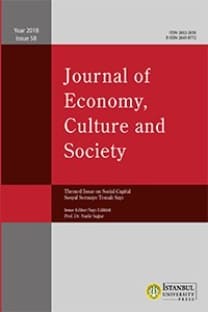Branding the Social: Leisure, Consumption, and the Corvette Community
This study explores the social world of Corvette car clubs and their membership based on social ties formed through common interests centered on consumption and leisure practice. This study contributes to the limited literature on brand communities that provide social capital in a postindustrial economy of intensified individualism that has experienced a decline in participation in voluntary associations. I address these factors through the framework of Robert Putnam’s classification of ‘bridging’ social capital or weak social ties that can be good for getting ahead. The cultural significance of the Corvette as America’s sports car is used as a unit of analysis in this ethnographic study of the brand community and its role in creating social capital for its members. The broad implication of this research reveals how the meaning assigned to consumer objects facilitates strong social networks that are productive in constructing identity and cementing relationships among fellow consumers and their communities. Ethnographic research methods were employed to design this sociological research. The data for this study was taken from 30 structured interviews with Corvette enthusiasts and 18 months of participant observation research. This study will fill a gap in the research on brand communities as organized leisure structures that facilitate social capital and renewed civic engagement in the public sphere.
Keywords:
lifestyle, leisure, consumption, brand community, Social capital brand community,
___
- Arnould, E., & Thompson, C. (2005). Twenty years of research. Journal of Consumer Research, 31(4), 868–882.
- Belk, R. (1988). Possessions and the extended self. Journal of Consumer Research, 15(2), 139–168.
- Belk, R. (2004). Men and their machines. Advances in Consumer Research, 31, 273–278.
- Belk, R., Wallendorf, M., & Sherry, J. (1989). The sacred and the profane in consumer behavior: Theodicy on the odyssey. Journal of Consumer Research, 16(1), 1–38.
- Bellah, R., Madsen, R., Sullivan, W., Swidler, A., & Tipton, S. (2008). Habits of the heart: Individualism and commitment in American Life. Berkeley, CA: University of California Press.
- Bishop, J., & Hoggett, P. (1986). Organizing around enthusiasms: Mutual aid in leisure. London, UK: Cornelia Publishing.
- Conley, D. (2009). Elsewhere U.S.A.: How we got from company man, family dinners, and the affluent society to the home office, blackberry moms and economic anxiety. New York, NY: Vintage Books.
- Cova, B. (1997). Community and consumption: Towards a definition of the linking value of product or services. European Journal of Marketing, 31(3–4), 297–316.
- Crouch, M., & McKenzie, H. (2006). The logic of small samples in interview- based qualitative research. Social Science Information, 45(4), 483–499.
- Csikszentmihalyi, M., & Rochberg-Halton, E. (1981). The meaning of things: Domestic symbols and the self. New York, NY: Cambridge University Press.
- Durkheim, E. (1977). The elementary forms of the religious life. London, UK: Allen and Unwin.
- Frey, J., & Dickens, D. (1990). Leisure as a primary institution. Sociological Inquiry, 60(3), 264–273.
- Glover, T., & Hemingway, J. (2005). Locating leisure in the social capital literature. Journal of Leisure Research, 37(4), 387–401.
- Goffman, E. (1959). The presentation of self in everyday life. New York, NY: Random House.
- Goldman, R., & Wilson, J. (1977). The rationalization of leisure. Politics & Society, 7(2), 157–187.
- Granovetter, M. (1973). The strength of weak ties. American Journal of Sociology, 78(6), 1360–1380.
- Hewer, P., & Brownlie, D. (2007). Cultures of consumption of car aficionados. International Journal of Sociology and Social Policy, 27(3–4), 106–119.
- Hirschle, J. (2014). Consumption as a source of social change. Social Forces, 92(4), 1405–1433.
- Levy, S. (1959). Symbols for sale. Harvard Business Review, 37(4), 117– 124.
- Muniz, A., & O’Guinn, T. (2001). Brand community. Journal of Consumer Research, 27(4),412–432.
- McPherson, M., Brashears, M., & Smith-Lovin, L. (2006). Social isolation in America: Changes in core discussion networks over two decades. American Sociological Review, 71(3), 353–375.
- National Council of Corvette Clubs. (October 2018). Retrieved from http://www.corvettesnccc.org/.
- Putnam, R. D. (1995). Bowling alone: America’s declining social capital. Journal of Democracy, 6(1), 65–78.
- Putnam, R. D. (2000). Bowling alone: The collapse and revival of American community. New York, NY: Simon & Schuster.
- Simply Analytics. (2018). Household membership- organizations/clubs: Member of civic clubs. EASI/MRI consumer survey: organization membership 2013. Retrieved October 10, 2018 from Simply Analytics database.
- Sheller, M. (2004). Automotive emotions feeling the car. Theory, Culture & Society, 21(4–5), 221–242.
- Solomon, M. (1983). The role of products as social stimuli: A symbolic interactionist perspective. Journal of Consumer Research, 10(3), 319–329.
- Stebbins, R. (1982). Serious leisure: A conceptual statement. Pacific Sociological Review, 25(2), 251–272.
- Wright, K. (2001). Generosity vs. altruism: Philanthropy and charity in the United States and United Kingdom. International Journal of Voluntary and Nonprofit Organizations, 12(4), 399–416.
- Zerubavel, E. (1991). The fine line: Making distinctions in everyday life. New York, NY: Free Press.
- ISSN: 2602-2656
- Yayın Aralığı: Yılda 2 Sayı
- Başlangıç: 1960
- Yayıncı: İstanbul Üniversitesi Yayınevi
Sayıdaki Diğer Makaleler
Tüketim Yoluyla Sosyal Sermaye Edinimi ve Tahvil Aracı Olarak Borçlanma
Türkiye’de Kültürel Sermayenin Öğrenim Başarısı Üzerine Etkisi
Mehmet CANSIZ, Bilgehan ÖZBAYLANL, Mustafa Hilmi ÇOLAKOĞLU
Sosyal Sermaye, İlişkiler ve Müzik Dünyası: Yeni Medyada Ağlar
Sekülerleşme ve Devlet: “Mardin Tezi”, Edebiyat Alanları ve Toplumsal Sermaye
Ortaöğretimde Okul Terki ve Sosyal Sermaye: Nitel Bir Araştırma
Gelenekselin Ötesi -Sen’in Yapabilirlik Yaklaşımının Sosyolojik Bir Eleştirisi-
